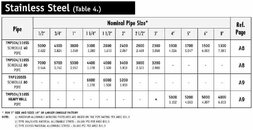If determined to find an alternative to spending the $400 on a production filter shell just some design pointers on our current design standards.
1. A minimum burst pressure of 25,000 psig including
2. A minimum working pressure to burst pressure ratio of 4:1.
3. A minimum certified pressure reversal (loading cyclic test) of 100,000 cycles.
One of the reasons of failure of the older imported compressors and there filters has been the failure of the 1.8:1 and the 3:1 ratio designs allowed in Germany under the TUV classification rules when run over a 15 year cycle life. In dive/fire shops these filters have been used as both filter/separators. The pressure cycle when combined with auto dumps, can be up to 4 pressure cycles per hour. Add to this the 1000 hour per year use. You can see where the 15 year life design now comes from.
Incidently IMHO the 3000psig WP in 4130 steel 0.250 wall on a 2 id is insufficient due to the steel corrosion allowance. 2 OD calculates out OK.
Our works standard hand flaring tools for hardened stainless steel and the most suitable tool for the job is the Imperial Eastman 37° ROL-AIR Flaring tool model 400-F. This beauty includes burnishing rollers to polish the flare. Three rollers in the flaring cone roll out the 37° flare above the die block. This maintains the tube original wall thickness as required under Mil Spec. Do lubricate the cone well before use.
New price is $923.70 from
http://www.newmantools.com/imperial/ft5.html. The pleasure in using it will last a lifetime. (well at least to my retirement) :14:
But I suppose you could also save more by buying a production filter shell $400.




